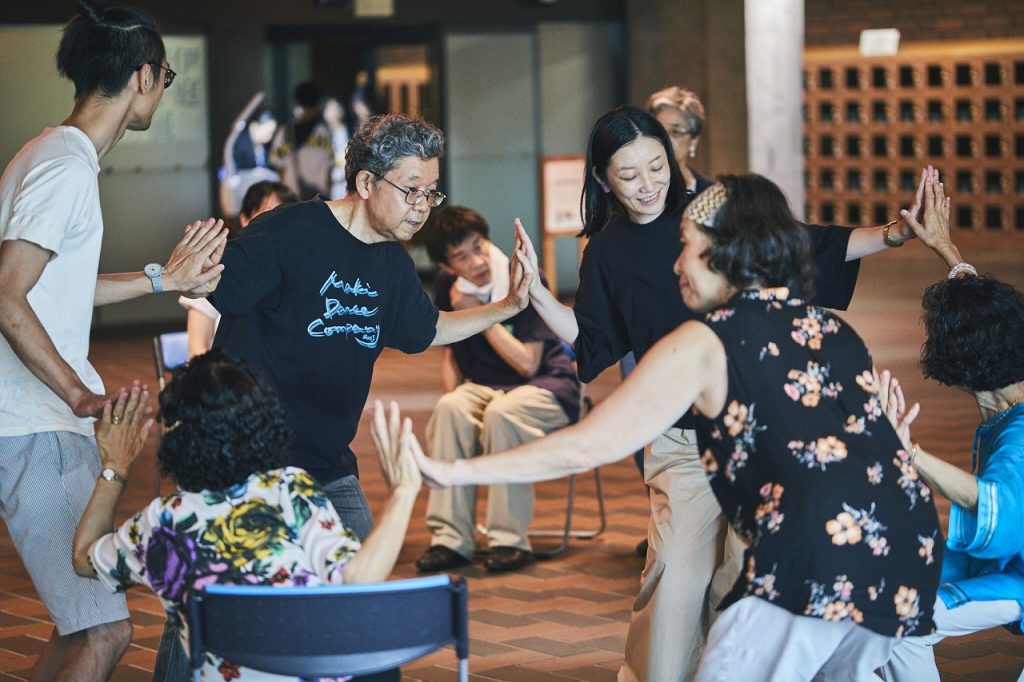
August 28, 2023
The Dance Well initiative at the Tokyo Metropolitan Art Museum
Kumi Shimokura
Curator, Tokyo Metropolitan Art Museum
Since 2019, the program “Dance Well” has been held regularly at the Tokyo Metropolitan Art Museum. Centered around individuals living with Parkinson’s disease, this expressive program is open to all, regardless of their medical condition or age, allowing the participants to engage with the museum’s spatial environment and artworks as they use their entire body to express the imagination and emotions that arise. The Tokyo Metropolitan Museum’s Dance Well initiative was recently introduced at the “International Museum Day Symposium” held under the theme “Museums for Sustainability and Well-being.” This article will share additional details of the program as well as a record of its implementation.
About Dance Well
“Dance Well – movement research for Parkinson” is a dance program initiated in 2013 by the Centro per la Scena Contemporanea (CSC) in Bassano del Grappa, a town in northern Italy that welcomes every participant, including those living with Parkinson’s disease, to engage in dance collectively. Parkinson’s disease is a progressive neurodegenerative disorder characterized by a reduced dopamine neurotransmitter in the brain. This reduction can lead to a loss of motivation, spontaneity, and various discomforting symptoms throughout the body and is said to occur more often in individuals over the age of 50. With increasing life expectancy and an aging population, the number of individuals with neurodegenerative conditions is said to be on the rise. Medical research has widely demonstrated the benefits of moderate exercise in managing Parkinson’s disease, and dance has been recognized as a form of rehabilitation.
Since the early 2000s, various dance programs embracing more spontaneous and creative approaches have spread globally; however, many programs are often conducted within established dance studios or companies. In contrast, “Dance Well” distinguishes itself by utilizing cultural facilities and artistic spaces, primarily centered around a municipal museum in the city center. It encourages participants to express their thoughts and emotions from their five senses through bodily movement and communal interaction. One significant aspect of “Dance Well” is its inclusivity, welcoming anyone as a “dancer” regardless of their medical condition. It opens the door to social engagement for individuals who may be distant from a community by fostering opportunities for interaction among participants and contributing to creating a new regional community in relation to the social inclusion of local culture.
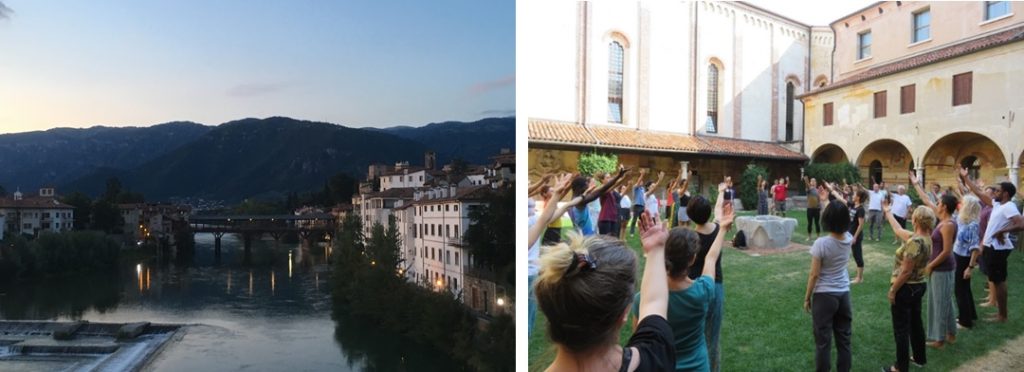
Right: Dance Well class at the courtyard of Museo Civico di Bassano del Grappa
Currently, the number of individuals aged 65 and above accounts for 29.1% of the total population in Japan, making it the highest among 200 countries and regions with a population of over 100,000. (Italy ranks second with 24.1%, according to the Statistics Bureau, Ministry of Internal Affairs and Communications of Japan in 2022). In response to this super-aging society, recent discussions during the “International Museum Day Symposium” have shed light on the pivotal role and possibilities of art museums and cultural institutions in leveraging their role of social inclusion, with initiatives aimed at combating social isolation and promoting collaboration for better health. With the above context, I wanted to put Dance Well into practice at the Tokyo Metropolitan Art Museum to create a place for new encounters and exchanges with artworks. After conducting field research and participating in a training program, I decided to try it as a public program for an exhibition starting in 2019.
Dance Well at the Tokyo Metropolitan Art Museum
Here, I would like to introduce the content of the Dance Well program at the Tokyo Metropolitan Art Museum and provide an overview of the programs that have been held so far.
The first instance of the program was connected to the summer exhibition “Yasuko Iba, A Way of Seeing” (July 20 to October 9, 2019). For this program, the museum invited Ms. Kurumi Nakamura, a dance artist who completed the training course in Italy in 2018 and is actively engaged with Dance Well Ishikawa in Ishikawa Prefecture. The program was led by Ms. Nakamura, and to gather participants, the museum received cooperation from the nationwide Parkinson’s disease support group, the “Japan Parkinson’s Disease Association.” As a result, 34 participants with Parkinson’s disease who have diverse backgrounds and an interest in art and dance therapy, ranging from their 20s to 80s, took part in two classes.
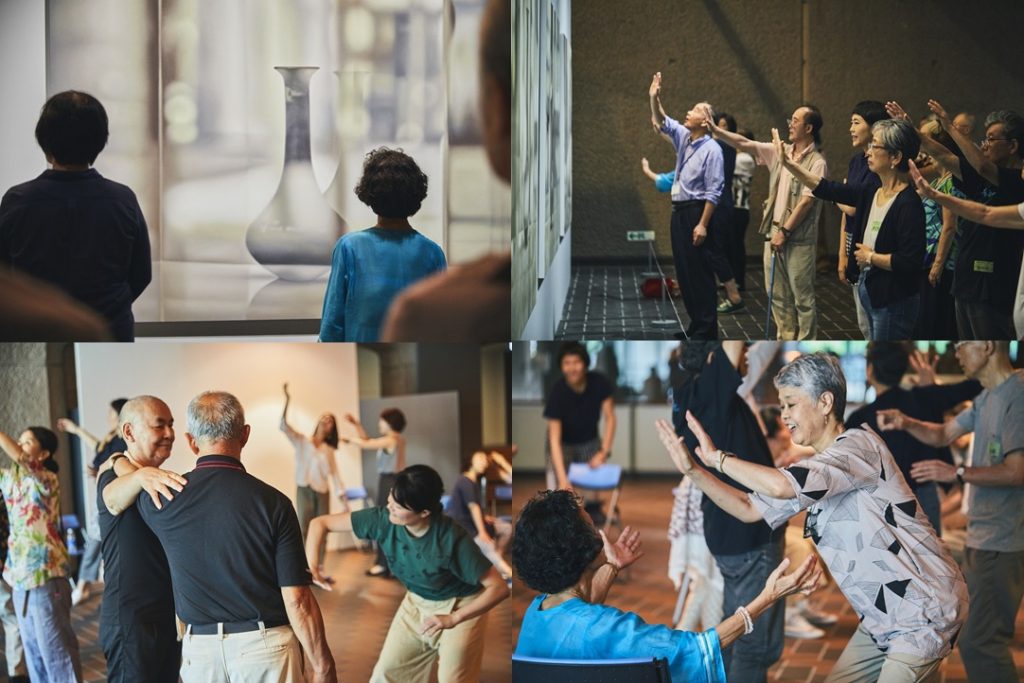
Photo by Yusuke Nakajima ©️Tokyo Metropolitan Museum
The Dance Well classes are structured to include elements that activate the body, such as the awareness of body and movement sensations (smooth movements, balance, rhythm, flexibility, etc.), choreography, and improvisational exercises. Generally, the classes are composed of five stages:
1) Introductory warm-up (often starting from a seated position)
2) Adding movements of the upper body and to the lower body
3) Trying movements while standing and holding onto a chair for support
4) Gradually moving away from the chair and introducing more significant and freer motions during the development phase.
5) The session concludes by bringing the breathing pace back down.
However, these are the fundamental structures and elements, and the actual content of the classes is continuously adjusted based on the instructor’s expressive style and theme, as well as the participants’ individuality (whether they are newcomers or experienced.)
The Dance Well at the Tokyo Metropolitan Art Museum is a 90-minute program that includes viewing the exhibition. After the warm-up, participants move to the gallery and receive a short introduction to the artworks. Standing before the chosen artwork, participants stretch out their hands while imagining the vastness of the meticulously depicted space and the backside of the motifs. After the group leaves the gallery, they layer paint onto their imaginary canvas, inspired by interviews with artists about their creative processes. Then, paired with another participant, they take turns becoming the “artwork” and the “observer,” appreciating it and exploring diverse perspectives and movements while opening up their bodies.
Participants commented, “How joyous to express oneself with the body and mind without the use of words,” “I feel creative and energized by everyone,” “The program brings smiles to the faces of those who met for the very first time,” and “The spiritual freedom I feel after examining the artworks leads to the feeling of freedom in my body. How we perceive the space and the artwork makes a gradual shift.” The program created a space for the participants to exchange physical expression through the viewing of art.
Attempts during the Pandemic
The following year, 2020, Dance Well was held as a program for the special winter exhibition ” Yoshida Hiroshi: Commemorating the 70th Anniversary of His Death ” (January 26 to March 28, 2021), but due to the spread of COVID-19, the event was held online. Together with two teachers, Ms. Momoko Shiraga (choreographer, director, and founder of Momonga Complex) and Mr. Naoyuki Sakai (dancer, filmmaker) (both of whom completed the training course in 2019), we discussed how to convert the Dance Well, which is usually conducted face-to-face, into an online program and implement it while maintaining its content. First, to convey the exhibition space and the essence of the works, we allocated time at the beginning of each class for a mini-lecture about the exhibition. Next, we introduced videos that showed the exhibition space and some selected works, along with the teachers’ movements as supplementary materials. Afterward, the two teachers took turns providing detailed guidance and support to facilitate a class.
During the class, participants traced the meticulous process of creating multi-color woodblock prints by Yoshida Hiroshi, which depicted majestic nature and cityscapes from around the world while using their bodies as a representation of the woodblocks, carving lines, and applying paint to create impressions, all while sharing their concrete images through the screen. Yoshida Hiroshi’s landscape paintings from various parts of the world brought about an intense feeling of wanderlust, especially during the restricted movement of the COVID-19 pandemic.
The participants commented, “By moving our bodies, we could integrate ourselves with the artist’s creative process and feel as if we were transcending time and space, being able to travel to the places and scenes the artist had visited.” “It was wonderful to discover new ways to enjoy paintings, move our bodies healthily, and be imaginative. It introduced me to a different viewpoint for my future museum visits.” This program provided an opportunity to learn new ways to enjoy the artwork (The class was held twice with a total of 49 participants).
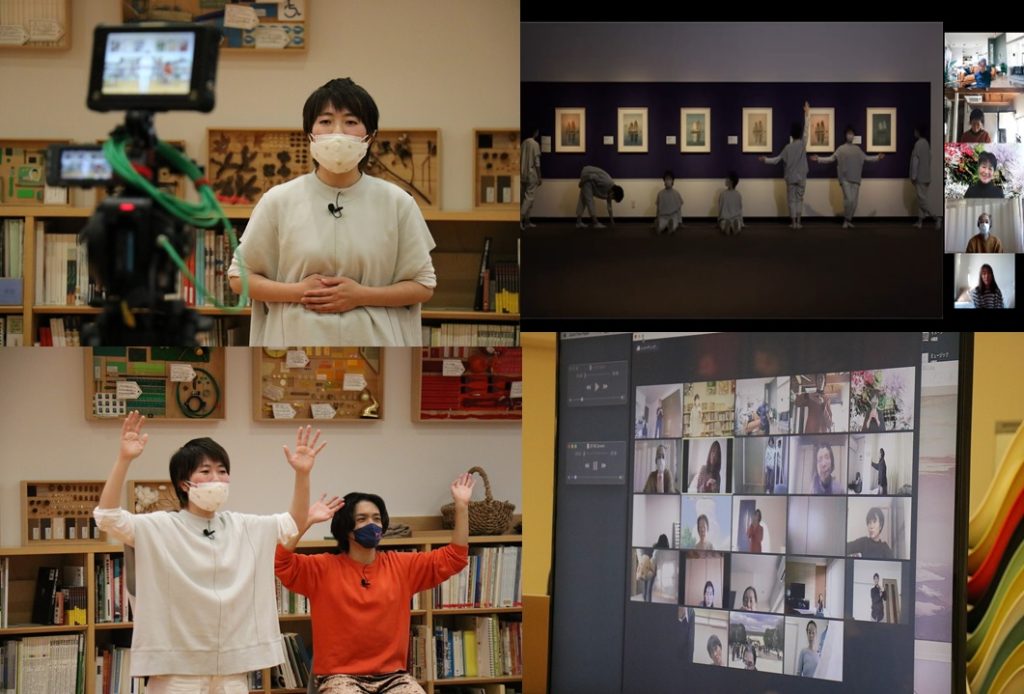
The third session was part of the special exhibition “Walls and Bridges – Touching the World, Living the World” (July 22 to October 9, 2021), again, with Ms. Kurumi Nakamura as the instructor. However, due to the impact of the fifth wave of COVID-19 infection, both participants and the instructor had to participate remotely in an online class. On the other hand, the convenience of the online format allowed participants to join from various regions, not only from around Tokyo but also from Tochigi, Gifu, Osaka, Ishikawa, and Hokkaido, resulting in 46 participants over the two days.
To convey the immersive experience of the exhibition, the class began by presenting videos of the exhibition scenes and setting up the live streaming inside the exhibition space to give a real-time sense of the atmosphere during the class. Additionally, a booklet containing selected artwork images and accompanying text chosen by the instructor was distributed to the participants in advance, so they could engage in movements while referencing the booklet.
One participant commented, “Instead of performing predetermined dances, Dance Well emphasizes dancing through a dialogue with our own body. It feels as if I am also a creator of art, just as an artist who goes through the process of creating artwork. It is a joyous feeling.” Despite the limited scope of interaction through the monitor, each participant was able to connect their movements with the experience of savoring the artwork.
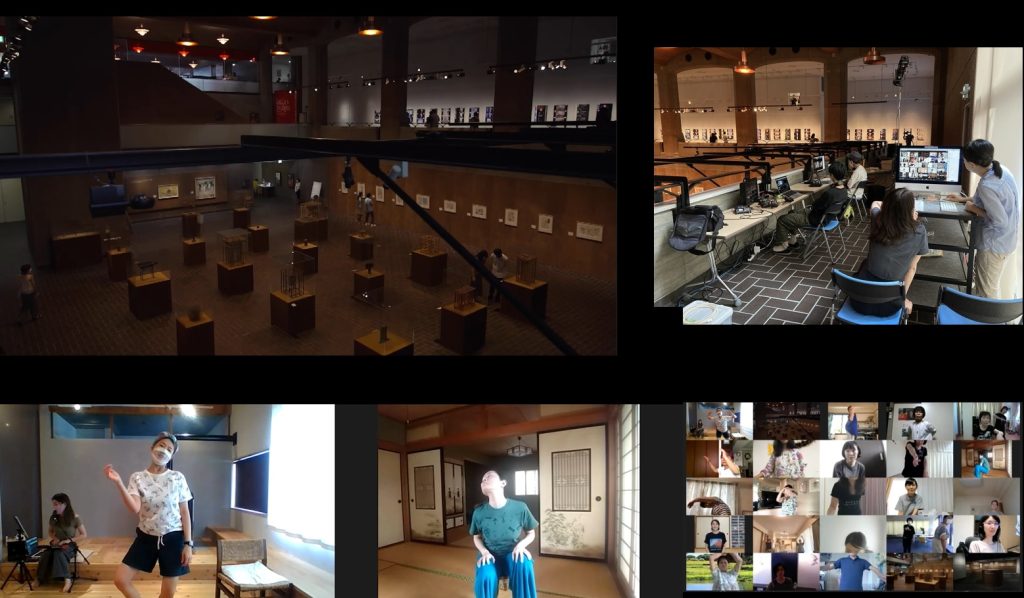
In 2022, as the infection prevention measures began to relax, in-person classes resumed after a hiatus of three years. The class was held in conjunction with the Ueno Artist Project 2022: “Beauty Nurtured by The Tale of Genji – It is Fate that Brings Us Together” (November 19, 2022, to January 6, 2023). The two classes, with reinvited lead instructor Momoko Shiraga, attracted 26 participants. The exhibition showcased artworks such as paintings, calligraphy, dyeing, and glass crafts created by contemporary artists on the theme of the story and characters of “The Tale of Genji,” which has been passed down for over a thousand years.
Participants first selected their favorite pieces and imagined touching the artworks in their minds, trying to “feel” their warmth and texture and the sounds emanating from them. As they moved from the gallery to the studio, they formed pairs and interacted at a distance where their hands almost touched, exchanging thoughts while moving together. At times, they placed their hands on each other’s backs and tried to interpret emotions through the subtle movement of the shoulder blades, engaging in various non-verbal dialogues.
The participants commented, “What a joy to be able to utilize all five of our senses. I felt a deeper connection to the artworks,” “I felt a sense of trust with these individuals despite meeting them for the first time,” The workshop provided an opportunity for participants to expand their minds and bodies in a safe and comfortable environment.
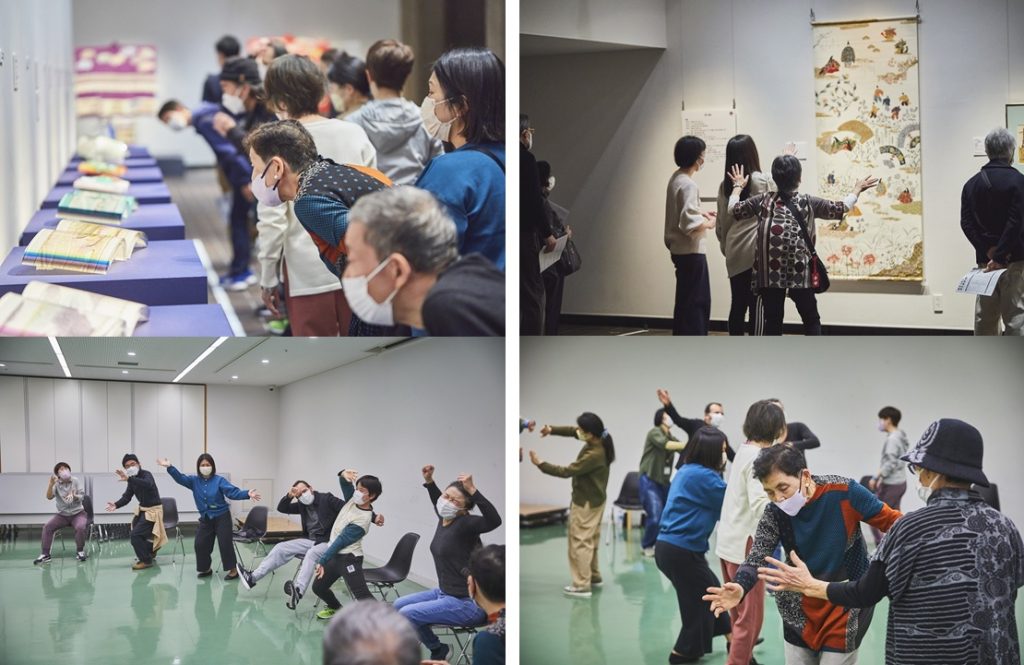
Photo by Yusuke Nakajima ©️Tokyo Metropolitan Museum
The Power of Dance Well as a Social Prescribing
As mentioned earlier, an important element of Dance Well is that it is not a gathering of only those living with Parkinson’s disease or a particular age group but a mixed group of people from various situations and ages. There, participants can freely expand their movements and enjoy each other’s company as one dancer, regardless of their roles in daily life, whether they are patients or caregivers. As they experience the classes, the participants begin to feel that the physical problems and awkwardness they have been negatively perceiving are positive elements of their unique characteristics and individuality. Dr. Tomohiro Nishi, a physician who also participated in our Dance Well program in 2022, described such characteristics as the “power of care” that Dance Well has on his YouTube social prescribing channel.
I recall a participant in a class in Italy saying, “I realized that having Parkinson’s disease allows me to move in unique ways that only I can,” this is an example of Dance Well’s “power of care.” Due to Parkinson’s disease being a progressive condition, voluntary body movements become increasingly challenging as the disease advances. Therefore, voluntarily moving one’s body can be seen as regaining control against the illness. I would also like to share the words of one participant who said, “After developing Parkinson’s disease, there were times when I felt overwhelmed by my limitations. It affected not just my physical abilities but also my emotional well-being. Today’s class liberated me from all of it.”
The “power of care” through Dance Well extends not only to those with Parkinson’s disease but applies to anyone who loves the arts and physical activity. Continuing this program in museums and galleries, Dance Well would be one of the new social prescriptions, taking advantage of the unique characteristics of their exhibitions and locations. Dance Well is expanding its network not only in Italy but also in Germany, France, the Czech Republic, and Lithuania. Furthermore, last year, the Jockey Club Dance Well Project, organized by the Hong Kong Academy for Performing Arts, was launched in Hong Kong. Other facilities affiliated with our foundation are also considering implementing Dance Well trials, and the possibilities of Dance Well in museums will continue to be explored.
Tokyo Metropolitan Museum Website
Top Image: Dance Well program for the exhibition “Yasuko Iba, A Way of Seeing”
Photo by Yusuke Nakajima ©️Tokyo Metropolitan Museum